Interview: Little Kaiju's TWiN
Check out this four-minute movie featuring the adorable character Little Kaiju and read an in-depth interview with Little Kaiju's directing team TWiN and animation director Nick Losq.
Little Kaiju was conceptualised and directed by Australian twins Jonathan and Josh Baker, aka TWiN, with animation director Nick Losq leading the post production team.
"We wanted to set a simple innocent children's fairytale around these themes and visuals, while maintaining a sophisticated tone that adults could also enjoy," says TWiN.
Watch this! Little Kaiju
Q: What were the film’s influences?
TWiN: Obviously the character and locations play heavily off of certain Japanese iconography, from their beloved 'kawaii culture' to the bright neon hustle and bustle of downtown Tokyo.
We wanted to set a simple innocent children's fairytale around these themes and visuals, while maintaining a sophisticated tone that adults could also enjoy. It's a delicate balance, but one we felt we could nail.
The quality of the film, photography and post-production needed to be totally believable in every way, so that nobody questioned the legitimacy of the character while watching the film. Kaiju had to be alive.
People can be so critical these days of visuals they see that aren't 100% genuine, and so we wanted to remove any skepticism off the table, allowing people to be totally immersed in the personal world of the character.
Regarding the story, we knew where we wanted it to go with Little Kaiju encountering a drunk 'salary man' in a dark alley, but wanted the majority of the film to be as spontaneous and abstract as possible. A largely silent film in the vein of a Pixar short, where our hero character didn't even have a mouth.
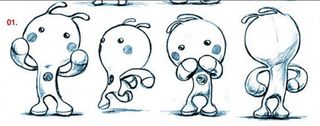
Having no mouth was a very deliberate decision, and forced us to project personality without the use of dialogue, or even traditional facial expressions.
Basically the short film is a series of moments that convey a feeling, more than a traditional narrative. It's about exploration and a childish sense of wonder.
It's about hanging out and taking the time to experience your surroundings. It's about the feeling of being 7 or 8 years old again.
Visually, it's also about 'light vs darkness' and illuminating shadowy corners to see what's out there in the big bad world. This was a major part of the character for us, and we really wanted his chest light to become a tangible in-camera element that interacted with his environment as he roamed the Tokyo streets.
But overall, it needed to be cute. Whether the film is your bag or not, we wanted everybody to admit that you simply can't hate on Little Kaiju. He's just too likable.
Naturally, a lot of this comes from his tiny appearance - his big head, small body, no mouth, fingers or toes. He's round and lovable in the way a toy might be.
Vinyl designer toys have always been a colorful and crazy subculture we've drawn inspiration from, and the character was definitely designed with this in mind. We also wanted an excuse to bring an actual toy into existence, and this project seemed like our best bet.
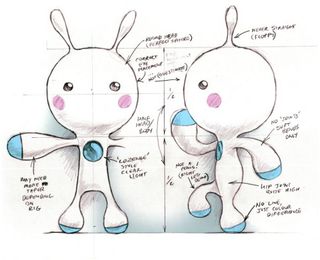
Q: What did you do on the short and what was the hardest job?
TWiN: We came up with the very simple story, helped design the Kaiju character with Morten Rowley from Supervixen, travelled to Tokyo Japan, shot the footage ourselves, and oversaw the post production from back in New York.
The hardest portion of the job was definitely asking for favors from very high-end professional people, despite a lot of them being close friends.
Nick Losq: I oversaw all animation and compositing on Little Kaiju, and put together a small crack team with a deliberate focus on the nuances of character animation.
I also agree that asking for favors was one of the hardest parts of the job, even though everyone was more than happy to be a part of such a character-focused project.
Q: How long did the animation take to produce? Have you ever produced anything before?
TWiN: The animation process was on and off for about five months.
At times it was more of an every day schedule, and at others it was whenever the animation team was available between paid jobs.
Our team mostly involved experienced riggers, animators, lighters, and compositors that Nick Losq had worked alongside on previous commercial jobs, and generally had a strong relationship with.
This was the first time we as TWiN had worked with any of the animation team including Nick, but are pretty certain it won't be our last.
For such a small group, with little past knowledge of each other, we were pleasantly surprised and impressed with the nuanced quality and integration of the CG.
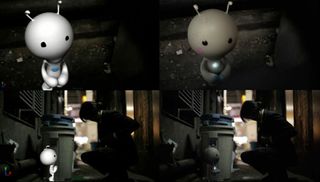
Q: What 3D software did you use and why?
Nick Losq: We used Maya 2011 for the entire project, and our pipeline was kept extremely simple so that we could maximize our limited artist time.
We used a character pipeline that relied heavily on referencing so that our artists could continue to work in parallel throughout the production, as many of our artists were working remotely. Our animators animated the referenced rig, and our lighters would then reference the animation to light the character.
Simplicity was our goal as this was an ambitious project to handle, and we were calling in a lot of favors with the team that contributed to it.
We wanted to make sure that everything was very straightforward and the assets were lean so that any artist could jump on board from anywhere in the world and not have technical issues, or have to deal with a massive download of assets that took up valuable time.
The rig and the shot cameras were all hosted on an ftp and animators would then upload animation files back to the ftp when they were done so they could be picked up by the lighting department. This kept our file sizes extremely small as nothing really lived in the Maya files except for the animation keys and some lights.
Q: What was the most useful piece of 3D software and why?
Nick Losq: There really wasn't a single piece of software that was more useful than any other. We just used those tool sets that we found most helpful out of each package.
The 3D was quite straightforward on this one, where we kept things simple relying heavily on doing the basics and trying to do them as well as possible.
After Effects and Photoshop, ironically were the most helpful, doing most of the heavy lifting in the paint work required for cleaning up many of the shots. The directors themselves were puppeteering practical lights in each shot, and they had to be removed and replaced with the lead character. Nuke was also used for plate cleanup as well as compositing for some shots.
Q: What was the most impressive technical aspect of the project and how was it achieved using 3D software?
Nick Losq: Although I wouldn't call it overly technical, the lighting of this project was what we are all the most proud of. Having no HDRI data to work with due to such a low-fi shoot, we created proxy geo of each location on which we projected our live action plates.
This allowed us to let the environment do the majority of the heavy lifting in adding the indirect values to Little Kaiju and giving us the time to dial in many of the moving lights that were captured in the plate photography. This technique worked amazingly well and has been something that we have tried to carry over onto all our projects since.
Q: Did you use or develop any new or notable techniques?
Nick Losq: Everything on this project was rather standard procedure in terms of the creation of the cg. It was what I would call an exercise focusing on the basics and doing them as best as we could.
The most notable technique in this project was that TWiN, the directing duo on the project, shot all the plates themselves while puppeteering a handheld light that would become the hero light on Little Kaiju's chest.
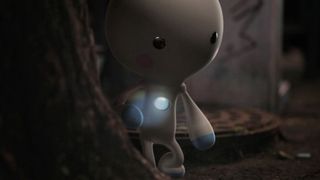
Their goal from day one was to have true light interaction in every shot.
This was a super smart technique to get as much out of our plates as we could, ensuring that we had actual physical integration between Kaiju and the way his chest light illuminated the environment.
TWiN: While our use of the on-set light did pose a few obvious challenges for the team in plate clean-up and paint work (the tail-less cat shot being a true offender), it was definitely worth all the extra effort to ground Kaiju into the world he's exploring.
99% of Kaiju's chest light bouncing around each scene was captured in camera, with one of us simply playing out different actions he could do once animated.
The only challenge with this technique was that the animators were then boxed into perfecting very specific moves based on the captured movement of the light.
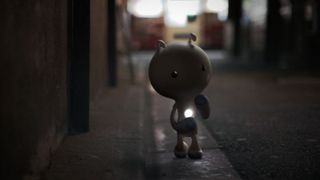
Q: Did you use any outside studio’s help?
Nick Losq: No. Everything was done under the banner of Rabbit Animation, with a small group of around seven talented artists.
Q: What do you do now? Are you working on anything interesting?
TWiN: Rabbit Animation as a team is growing nicely, and are working on a multitude of commercial projects out of the Rabbit LA office.
As TWiN, we try to jump between different mediums, having recently finished a pop video for Lupe Fiasco, and are now out on the road across America shooting for a Global Top 10 corporation.
We do what we can to keep things creatively fresh, despite the fact that advertising generally takes the front seat. Due to the amount of fun had on Little Kaiju, hopefully more short films are in our immediate future.
Nick Losq: Rocking it! And hell yea the stuff I am working on now is interesting!
Q: Your short is not only a great story, but technically brilliant - where do you hope it will take you?
TWiN: Little Kaiju was done simply as a passion project for us to stay creatively involved with something that wasn't ad work. In the grand scheme of things it was a tiny idea, and was never supposed to be our grand opus. At no point were we going 'all in' for our careers on this short film.
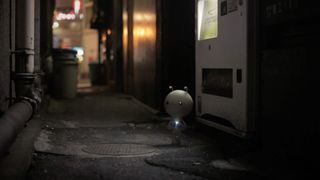
We simply had an overall tone and some techniques we wanted to explore. Because of this simple beginning, it's been quite amazing watching the response Little Kaiju has gotten online.
We knew he was adorable, but wasn't anticipating just how much love the little guy was going to get in what is a very cynical international creative community. A rather emotional (and verbal) response has come from so many different countries, and thankfully Japan has been high on that list.
We'd be lying if we said we weren't slightly concerned with how Tokyo was going to respond to two foreigners presenting a fictional version of their city.
We've been asked a lot lately whether there will be further adventures for Little Kaiju - both in the short film, feature film, and even comic book form.
It's not something we went in with a plan for, even though we are well aware of the recent trend of shorts being sold and fast-tracked into features. It's something we've definitely discussed, and there are loose story ideas for a quite sophisticated and entertaining film centered around the Little Kaiju character being discovered in the dark underbelly of Tokyo.
Thanks for the fantastic interview guys. Glad to hear it's all going well for you, and that everything you're working on is interesting, Nick! Keep rocking it.

Thank you for reading 5 articles this month* Join now for unlimited access
Enjoy your first month for just £1 / $1 / €1
*Read 5 free articles per month without a subscription

Join now for unlimited access
Try first month for just £1 / $1 / €1
Get the Creative Bloq Newsletter
Daily design news, reviews, how-tos and more, as picked by the editors.
The Creative Bloq team is made up of a group of design fans, and has changed and evolved since Creative Bloq began back in 2012. The current website team consists of eight full-time members of staff: Editor Georgia Coggan, Deputy Editor Rosie Hilder, Ecommerce Editor Beren Neale, Senior News Editor Daniel Piper, Editor, Digital Art and 3D Ian Dean, Tech Reviews Editor Erlingur Einarsson and Ecommerce Writer Beth Nicholls and Staff Writer Natalie Fear, as well as a roster of freelancers from around the world. The 3D World and ImagineFX magazine teams also pitch in, ensuring that content from 3D World and ImagineFX is represented on Creative Bloq.
